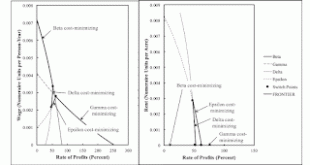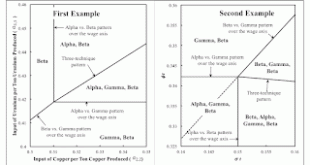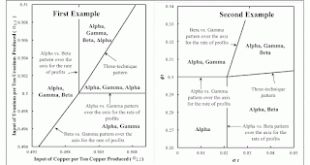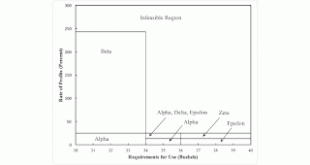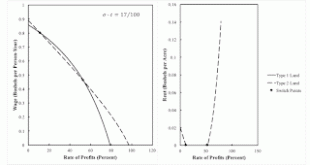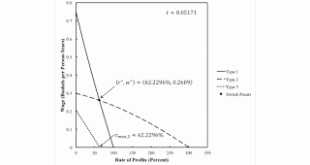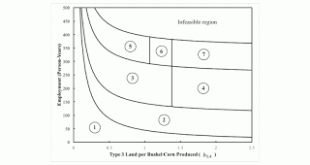Figure 1: The Wage Frontier And Rent This post is merely a worked homework example, problem 7.10 in Kurz and Salvadori (1995). I have not considered yet which parameters I want to explore perturbing. As a matter of history, Anderson, West, Malthus, and Ricardo took extensive rent as the paradigm case, and confined it to land. They imposed no limit on the production of industrial commodities. Ricardo, at least, also discussed the case of intensive rent. The marginalists, on the other hand,...
Read More »A Structure in Parameter Space with Three Patterns Across The Wage Axis
Figure 1: Three Patterns Across The Wage Axis And One Three-Technique Pattern This post continues the approach in this post and in this post. As previously stated, I consider the same two examples. In both examples, three processes are known for producing the numeraire, called "corn". In the example for the left panel, corn is a non-basic commodity, and a different basic commodity is used in each of the three techniques. In the example for the right panel, all three corn-producing processes...
Read More »A Structure in Parameter Space With Three Patterns Across The Axis For The Rate Of Profits
Figure 1: Three Patterns Across The r Axis And One Three-Technique Pattern This post continues the approach in this post. I consider the same two examples. In both examples, three processes are known for producing the numeraire, called "corn". In the example for the left panel, corn is a non-basic commodity, and a different basic commodity is used in all three techniques. In the example for the right panel, all three corn-producing processes require inputs of labor power, corn, and labor (in...
Read More »A Structure In Parameter Space
Table 1: A Common Structure Example1.0 Introduction This post presents partitions of (a part of) parameter space for two examples of models of prices of production with a choice of technique. The examples have a different structure and are parametrized differently. Yet, I want to argue, the partitions are the same, at some level of abstraction. 2.0 Thing 1 The first example is an instance of the Samuelson-Garegnani model. Table 1 presents the coefficients of production for this example....
Read More »Summary of Some Conclusions From My Research Program
This blog, over years, presents a welter of fluke cases. I created many of the numerical examples to illustrate the reswitching of techniques, capital reversing, or some such so-called 'perversity'. Fluke cases can be combined. For example, a fluke switch point at a rate of profits of zero can also be a fluke switch point at which three wage curves intersect. Or two switch points on the wage frontier can both be fluke switch points at which four wage curves, not necessarily the same,...
Read More »An Intensive Rent Example From Freni
Figure 1: A Pattern Diagram1.0 Introduction Aside, perhaps from the above visualization, nothing novel is presented in this post. It follows an example presented by Freni (1991). I know of this example from problems 7.7 and 7.29 in Kurz and Salvadori (1995). The oddities of this example can be seen in an earlier and more complicated example from D'Agata (1983). This is an example of intensive rent. When the requirements for use are large enough, capitalists will use more than one process...
Read More »Extensive Rent For A Reswitching Example
Figure 1: Wage Curves and Rent1.0 Introduction I might as well illustrate an example with extensive rent and reswitching. I find it incredible that the agents in these sorts of models understand the implications of, say, a variation of the distribution of income for their self-interests. Nevertheless, I try to note the consequences of variation in the distribution of income and perturbations of model parameters on prices of production. And I do not worry too much about disequilibria. 2.0...
Read More »Fluke Cases for the Order of Fertility
Figure 1: Wage Curves for Fluke Case for r-Order of Fertility1.0 Introduction This post illustrates two fluke cases that can arise in a model with land and extensive rent. I call these a pattern of switch points for the r-order of fertility and a pattern of switch points for the w- order of fertility. I have previously described a fluke case in the order of rentability, which can be either over the wage axis or over the axis for the rate of profits. These fluke cases can arise in an...
Read More »Flukes In A Modification Of An Example With Land
Figure 1: A Partition of a Slice of the Parameter Space1.0 Introduction This post presents another example from Woods (1990). It is a modification of this example. That previous example demonstrates that the order of fertility - the order in which lands of various types and that support different processes of production are taken into cultivation - varies with distribution. If the wage were different, the order of fertility could be different. Furthermore, the order of rentability - the...
Read More »Flukes In An Example With Land
Figure 1: A Partition of a Slice of the Parameter Space1.0 Introduction This post tells a story in which owners of a certain type of land find the amount of their land needed to produce net output declines. Wages stay constant, and the rent for some landlords increases. This example is generalized from Woods (1990). 2.0 Technology This an example (Table 1) of a capitalist economy in which two commodities, iron and corn, are produced. One process is known for producing iron. In the iron...
Read More » Heterodox
Heterodox

